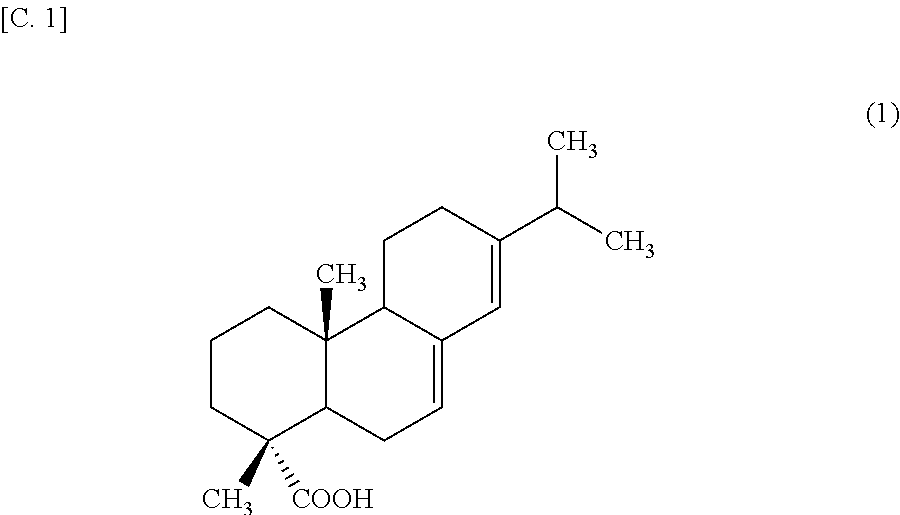Chloroprene rubber composition and adhesive composition using said chloroprene rubber composition
a chloroprene rubber and composition technology, applied in chloroprene adhesives, adhesive types, graft polymer adhesives, etc., can solve the problems of many conventional methods still insufficient, and achieve the effects of superior discoloration resistance, simple and convenient polymerization methods, and superior quality as adhesives
- Summary
- Abstract
- Description
- Claims
- Application Information
AI Technical Summary
Benefits of technology
Problems solved by technology
Method used
Image
Examples
example 1
[0114]0.3 parts by mass of sodium salt of a β-naphthalenesulfonic acid formalin condensate (trade name: “FD-40” (registered trademark), produced by Dai-ichi Kogyo Seiyaku Co., Ltd.) and 0.01 parts by mass of sodium sulfite were added to and dissolved in an aqueous emulsifier solution prepared by mixing 120 parts by mass of water, 4.0 parts by mass of a rosin acid sodium salt (trade name: “Rondis 3R”, produced by Arakawa Chemical Industries, Ltd.), and 0.5 parts by mass of potassium hydroxide. The solution was stirred in a reactor having a capacity of 5 liters and 100 parts by mass of chloroprene and 0.1 parts by mass of n-dodecylmercaptan were added thereto. The solution was then subjected to emulsion polymerization under nitrogen gas atmosphere at 10° C., using 0.05 parts by mass of potassium persulfate as polymerization initiator. When the final polymerization rate reached 70%, an emulsion containing 0.5 parts by mass of 2-methyl-4,6-bis-octylthiomethylphenol (trade name: “Antage ...
example 2
2. Example 2
[0147]In Example 2, the composition of the chloroprene rubber composition and the adhesive using the same suitable for them to show favorable discoloration resistance under heat or light was studied.
[0148][Preparation of Chloroprene Rubber Composition]
[0149]Chloroprene rubber compositions of Examples 12 to 29 and Comparative Examples 2 and 3 were prepared by the methods shown below.
example 12
[0150]0.3 parts by mass of sodium di-2-ethylhexyl sulfosuccinate (trade name: “RAPISOL A-90” (registered trademark), NOF Corp.) and 0.01 parts by mass of sodium sulfite were added to and dissolved in an aqueous emulsifier solution obtained by mixing 120 parts by mass of water, 4.0 parts by mass of a rosin acid sodium salt (trade name: “Rondis 3R”, produced by Arakawa Chemical Industries, Ltd.), and 0.5 parts by mass of potassium hydroxide. 100 parts by mass of chloroprene and 0.15 parts by mass of n-dodecylmercaptan were added to the solution placed in a reactor having a capacity of 5 liters, as it is agitated. The solution was then subjected to emulsion polymerization under nitrogen gas atmosphere at 10° C., using 0.05 parts by mass potassium persulfate as polymerization initiator. When the final polymerization rate reached 70%, an emulsion of 0.06 parts by mass of 2-methyl-4,6-bis-octylthiomethylphenol (trade name: “Antage HP-400”, produced by Kawaguchi Chemical Industry Co., Ltd....
PUM
| Property | Measurement | Unit |
|---|---|---|
| temperature | aaaaa | aaaaa |
| pH | aaaaa | aaaaa |
| temperature | aaaaa | aaaaa |
Abstract
Description
Claims
Application Information
 Login to View More
Login to View More - R&D
- Intellectual Property
- Life Sciences
- Materials
- Tech Scout
- Unparalleled Data Quality
- Higher Quality Content
- 60% Fewer Hallucinations
Browse by: Latest US Patents, China's latest patents, Technical Efficacy Thesaurus, Application Domain, Technology Topic, Popular Technical Reports.
© 2025 PatSnap. All rights reserved.Legal|Privacy policy|Modern Slavery Act Transparency Statement|Sitemap|About US| Contact US: help@patsnap.com

